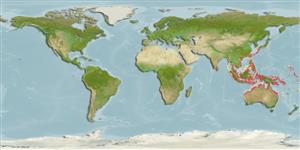Environment: milieu / Klimaatzone / Diepte / distribution range
Ecologie
marien; zoet water; brak water benthopelagisch; amfidroom (Ref. 46888); diepte 0 - 6 m (Ref. 90102). Tropical
Asia and Oceania: India, Hong Kong, Malaysia, Indonesia and Australia.
Grootte / Gewicht / Leeftijd
Maturiteit: Lm ? range ? - ? cm
Max length : 10.0 cm SL mannelijk / geslacht onbekend; (Ref. 7050)
Dorsale stekels (totaal) : 6 - 7; Dorsale zachte stralen (totaal) : 11 - 12; Anale stekels: 1; Anale zachte stralen: 9 - 10. Characterized by pale grey to brownish body color grading to white on lower half; dark brown scale margins forming honeycomb pattern; presence of narrow dark brown to blackish stripe from rear edge of eye to above base of pectoral fin; dorsal and lower part of caudal fins with dark spotting; fully united pelvic fins with well developed frenum; rounded caudal fin, about equal to head length; longitudinal scale series 32-38; predorsal scales 12-16, reaching interorbital space; ctenoid body scales, becoming cycloid anterior to pectoral and pelvic fins; scales absent on cheek, 1-2 rows on anterodorsal part of operculum; depth of body 4.7-6.4 in SL (Ref. 90102).
Body shape (shape guide): elongated.
Inhabits sand or mud bottoms of estuaries and sheltered shoreline reefs in 0-6 m (Ref. 90102).
Levenscyclus en paargedrag
Maturiteit | Voortplanting | Paaien | Eieren | Fecunditeit | Larven
Genital papilla of male sometimes heavily pigmented, reaching anal spine. Genital papilla of female truncate, ending well short of anal spine.
Kottelat, M., A.J. Whitten, S.N. Kartikasari and S. Wirjoatmodjo, 1993. Freshwater fishes of Western Indonesia and Sulawesi. Periplus Editions, Hong Kong. 221 p. (Ref. 7050)
Status op de Rode Lijst van het IUCN (Ref. 130435: Version 2024-2)
Gevaar voor de mens
Harmless
Gebruik door de mens
Tools
Speciale rapporten
Download XML
Internetbronnen
Estimates based on models
Preferred temperature (Ref.
123201): 24.7 - 29.3, mean 28.6 °C (based on 2826 cells).
Fylogenetische diversiteitsindex (Ref.
82804): PD
50 = 0.5005 [Uniqueness, from 0.5 = low to 2.0 = high].
Bayesian length-weight: a=0.00724 (0.00339 - 0.01546), b=3.10 (2.92 - 3.28), in cm total length, based on LWR estimates for this (Sub)family-body shape (Ref.
93245).
Trofisch niveau (Ref.
69278): 3.4 ±0.4 se; based on size and trophs of closest relatives
Weerstandsvermogen (Ref.
120179): Hoog, minimale populatieverdubbelingstijd minder dan 15 maanden (Preliminary K or Fecundity.).
Fishing Vulnerability (Ref.
59153): Low vulnerability (10 of 100).
🛈
Nutrients (Ref.
124155): Calcium = 292 [148, 635] mg/100g; Iron = 1.07 [0.55, 2.08] mg/100g; Protein = 16.9 [15.0, 18.5] %; Omega3 = 0.135 [0.046, 0.326] g/100g; Selenium = 28.5 [11.9, 64.1] μg/100g; VitaminA = 55.2 [16.3, 161.7] μg/100g; Zinc = 2.64 [1.80, 3.93] mg/100g (wet weight);
